Note: From September 26, 2022, only the test-on-arrival process from this post will apply to you. Please see this post for more information
Ever since 2020, Hong Kong Airport has really tightly controlled entry, with quarantine durations ranging from 3 (current) to 21 days. Earlier this week I arrived Hong Kong for the second time since the COVID-19 pandemic started, and wanted to write a post detailing what you should expect when arriving the airport. Regardless of how you feel about having to quarantine, I felt like the arrivals experience from plane to DQH was very smooth, and don’t consider the arrivals process to be a travel deterrent or something to dread (I’m talking specifically about the airport procedures, and not the quarantine that follows).
Hong Kong currently has a “3+4” quarantine scheme, requiring three days of hotel quarantine and four days of medical surveillance (during these four days, I’m allowed to take public transport and visit outdoor parks, other people’s homes, etc., but not allowed to visit any places that check my vaccine pass, including bars, restaurants, church, etc., as well as high-risk places such as elderly homes).
Obviously I couldn’t do a photo documentation of the entire arrivals process, which involved filling out a health declaration form online, RT-PCR testing before departure, COVID-19 (both RT-PCR and rapid antigen) testing upon landing, receiving a three-day quarantine order, getting an airport shuttle to a designated quarantine hotel (DQH), undergoing testing at my DQH, and getting released from the hotel at a particular time. I’m writing this post to indicate what you can expect timings wise (though have added on a couple of pictures).
I’ve called Hong Kong home my whole life (and don’t have citizenship in any other country – I live in the UK on a Tier 4 visa), so I’m not going to comment on how necessary this is, given that my perception may be skewed as a local resident. However, if you live, work, or study here, or have decided to take the “3+4” quarantine scheme as a reason to finally travel (whether that’s to Hong Kong, or you’re a Hong Kong resident visiting elsewhere), I hope this post is helpful to you.
What You Need To Fly Into Hong Kong Airport
At the moment, only fully vaccinated travellers are allowed into Hong Kong, regardless of whether you’re a citizen, or travelling. You’ll also be allowed into Hong Kong if you’ve been deemed unfit to be vaccinated (whether you have one dose, or none at all – you’ll need a doctor’s note), or if you’re under 11. You’ll also need a 3-night hotel reservation at a designated quarantine hotel (DQH), or a 14-night reservation if you’re deemed unfit to be vaccinated. Keep in mind that this is relative to your scheduled arrival – if you lose a night as a result of an airline-caused delay, you’ll still be allowed to board (I’m not sure what happens if you misconnect on separate tickets, though all you need is a green QR code, so you should be fine as long as you communicate with authorities in Hong Kong).
To board, you’ll need (this is what you specifically need to show check-in/gate agents, and implies other requirements, such as a DQH reservation):
- A negative RT-PCR test certificate taken within 48 hours of your Hong Kong-bound flight (which no longer has to be from an approved provider, as long as the certificate states specifically that the result was a RT-PCR result, and not a rapid antigen or LAMP test)
- If you’ve tested positive within 14 to 90 days of arrival, present proof of testing positive instead (this can be a GP letter, a PCR positive result, a hospital discharge summary, an isolation order, or an official letter – get a letter from your GP if you’re planning to go to Hong Kong and test positive for COVID-19 beforehand), as well as a negative rapid antigen test taken within 24 hours of departure
- A green QR code from a health declaration form (fill it out via this link within 96 hours of arriving – you don’t need a PCR negative result to fill this form out), which asks for your vaccination details and your hotel room confirmation number (you should get this via email)
- If you don’t have a hotel room confirmation number, you’ll get a pink QR code, in which case you’ll need a printed confirmation of your room reservation
- Save the health declaration QR code to your mobile device, or print it out (I’d say this is probably the most important step that was least clearly instructed)
You should also:
- Download the LeaveHomeSafe app early, and enter your vaccination details (you can easily do this during quarantine, but make your life easier if you can – or else check-out might be very stressful if you happen to forget)
- As long as you download the app, you’ll automatically be given a vaccine pass to enter restaurants, bars and other vaccine pass premises on the morning of the 7th day after your arrival (counting from day 0) – you don’t need to do anything extra for this
- Have a paper copy of your vaccination records and DQH reservation, especially if you’re connecting (where check-in agents are less familiar with the rules)
Getting Ready To Fly Into Hong Kong Airport (from London)
Shortly after I booked my Turkish Airlines itinerary, I went on Randox’s website and booked a 3-hour turnaround PCR test for £85 (I used a Cathay Pacific discount code, despite not flying them). This isn’t cheap at all, and wasn’t particularly necessary – a 24-hour return would’ve been early enough, despite the fact that I was transiting – though as someone returning to Hong Kong for the first time in a while I wanted to be absolutely sure that I received my result far enough in advance. Also, Randox probably wasn’t the cheapest out of the options, but any institution that manages to put ads for male testicular health checks on the London Underground is worth my patronage (because it’s not the sort of thing you’d otherwise expect on the Tube, and not because it’s not a very important checkup…).
If your office provides free PCR testing, you should be able to use this, which wasn’t the case in the past (as long as the office issues certificates, and the certificate clearly states that an RT-PCR test took place – Imperial College used to offer free PCR testing, though unfortunately the test center had closed down since).
The office hours of the Randox office I booked my test at decided to change their opening hours to weekdays only (I was flying on a Monday, so booked a test for Sunday), though Randox quickly rebooked me to a different test center upon request. I was 10 minutes late and couldn’t find the Chiswick office’s phone number, though they gave me a call, and were otherwise quite flexible with timings. The COVID test took all of 2 minutes, and I was on my way.
A certificate for a negative test was issued an hour and a half after my test was taken (I’ve blurred out all sensitive information below, but send a birthday gift my way if you wish). The most painful part about the test was definitely the associated £80 that came with it.
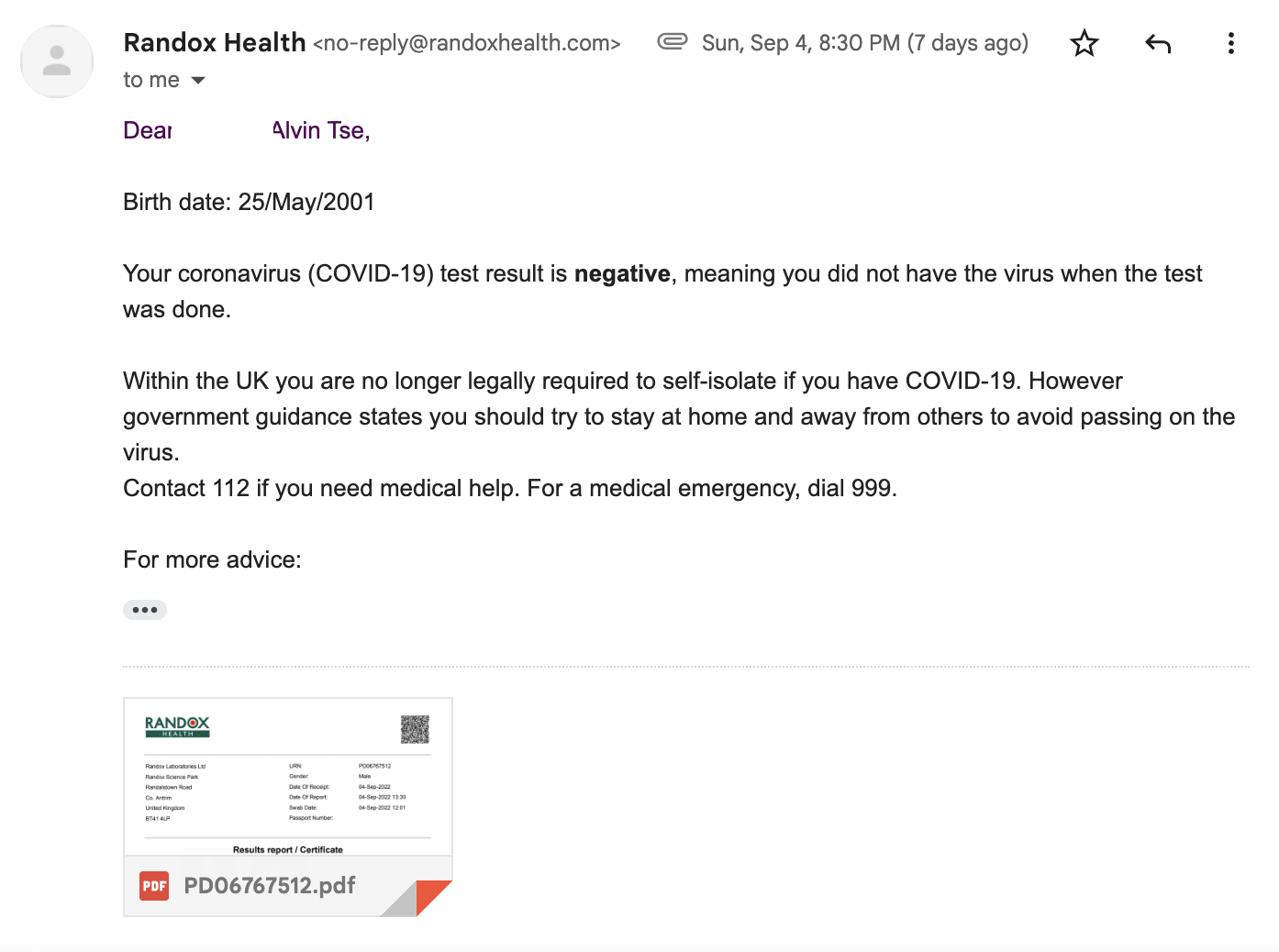
I also filled out the government health declaration form, which took around 10 minutes, and required me to upload information of each COVID-19 vaccine dose I entered manually (including the NHS QR code, batch number, etc., all provided on the certificate). If you accidentally close your browser after your QR code has been issued, re-open the same browser and click the “QR code finder” button on the bottom right hand corner. You’ll want to save your QR code as a photo, though, and send it to your mobile device or print it out.
Turkish Airlines didn’t ask me for any of these documents upon online-check in. The Turkish Airlines check-in counter at Gatwick Airport asked me for my DQH reservation, green QR code, and PCR test upon bag drop, and my QR code and PCR test were checked before boarding my Istanbul to Hong Kong flight.
COVID-19 Testing Upon Arrival at Hong Kong Airport
While masks are required on all public transport by the Hong Kong government (this includes flights in and out of Hong Kong), mask wearing was not enforced onboard my flight.
After my Turkish Airlines 777 landed at Hong Kong Airport, business class passengers were invited to get off the plane first. Instead of heading towards immigration and baggage collection, we were directed in the opposite direction (towards gate 35 – we alighted at gate 28), and joined a queue to be COVID-19 tested by gate 35. We weren’t the only flight that had just arrived, though there are far fewer flights at Hong Kong Airport than there used to be, so there wasn’t much of a queue.
Within a couple of minutes we went through the below:
- Our green QR codes were scanned, and we were given lanyards with a bar code on the back
- Our lanyards were scanned, and we were given a COVID-19 test tube and directed to cubicles for testing
- Four separate swabs were taken: two nasal swabs and two throat swabs (one each for a rapid antigen and PCR test) – the nasal swabs were probably the most pathetic swabs I’d had thus far, and barely went into my nostrils
This took less than five minutes, where we were directed to the automated people mover train that brought us back to the arrivals hall. London Gatwick and Istanbul Airport both have something to learn from Hong Kong Airport in terms of clear signage – never once did I feel lost (granted the tone felt a bit different here).
Immigration and baggage collection proceeded as normal (much like before, you’ll be able to enter Hong Kong if you don’t otherwise need a visa, as long as you fulfil all vaccination requirements and have a hotel reservation), though we weren’t allowed to leave the baggage collection area until our rapid antigen test results had come back. My bag reached the conveyor belt before I did, and upon attempting to leave the baggage collection area, my lanyard bar code was scanned and I was told to wait for six minutes (I appreciated the accurate timing – nothing annoys me more than a 20-minute wait that’s “about five minutes” long). During that time I needed to use the bathroom, and one of the airport staff (all in PPE) helpfully agreed to look after my bag while I did so.
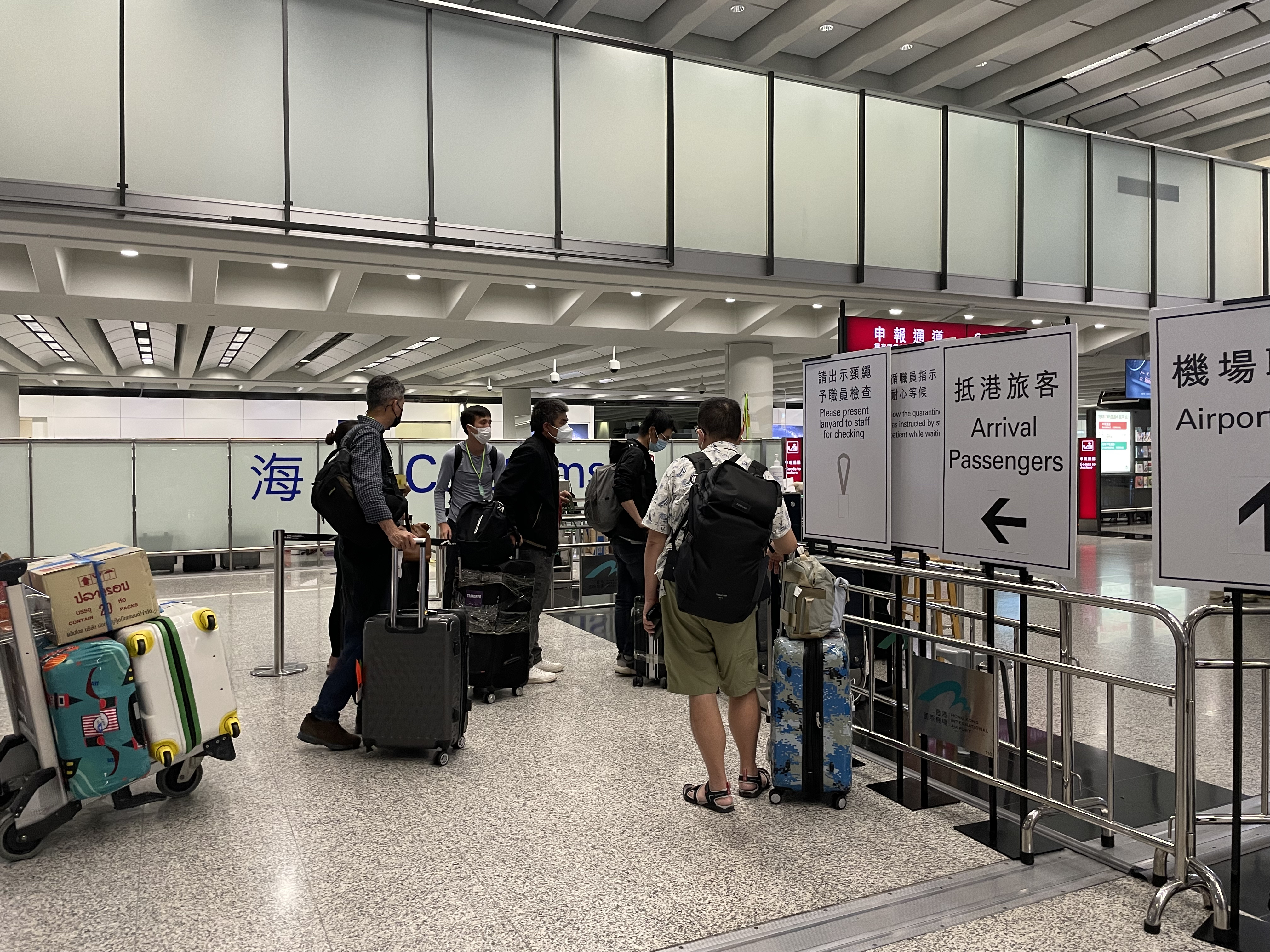
Waiting for my rapid antigen test result to come back after collecting my bags
There was a short queue to leave the baggage collection area at all times, though it moved very quickly. There were multiple “checkpoints” into to both pathways into the arrivals hall. I got past at 6:40 PM, about half an hour after I’d gotten off my aircraft.
Waiting For A Designated Quarantine Hotel Shuttle At Hong Kong Airport
Once reaching the arrivals area, I was greeted by a sea of perimeter control cordons. We were given the option to take a designated taxi straight to our quarantine hotel (the taxi drivers are instructed not to stop midway), though I didn’t have Hong Kong currency on me and wasn’t in a rush at all. I decided to wait for one of the shuttle buses to my DQH.
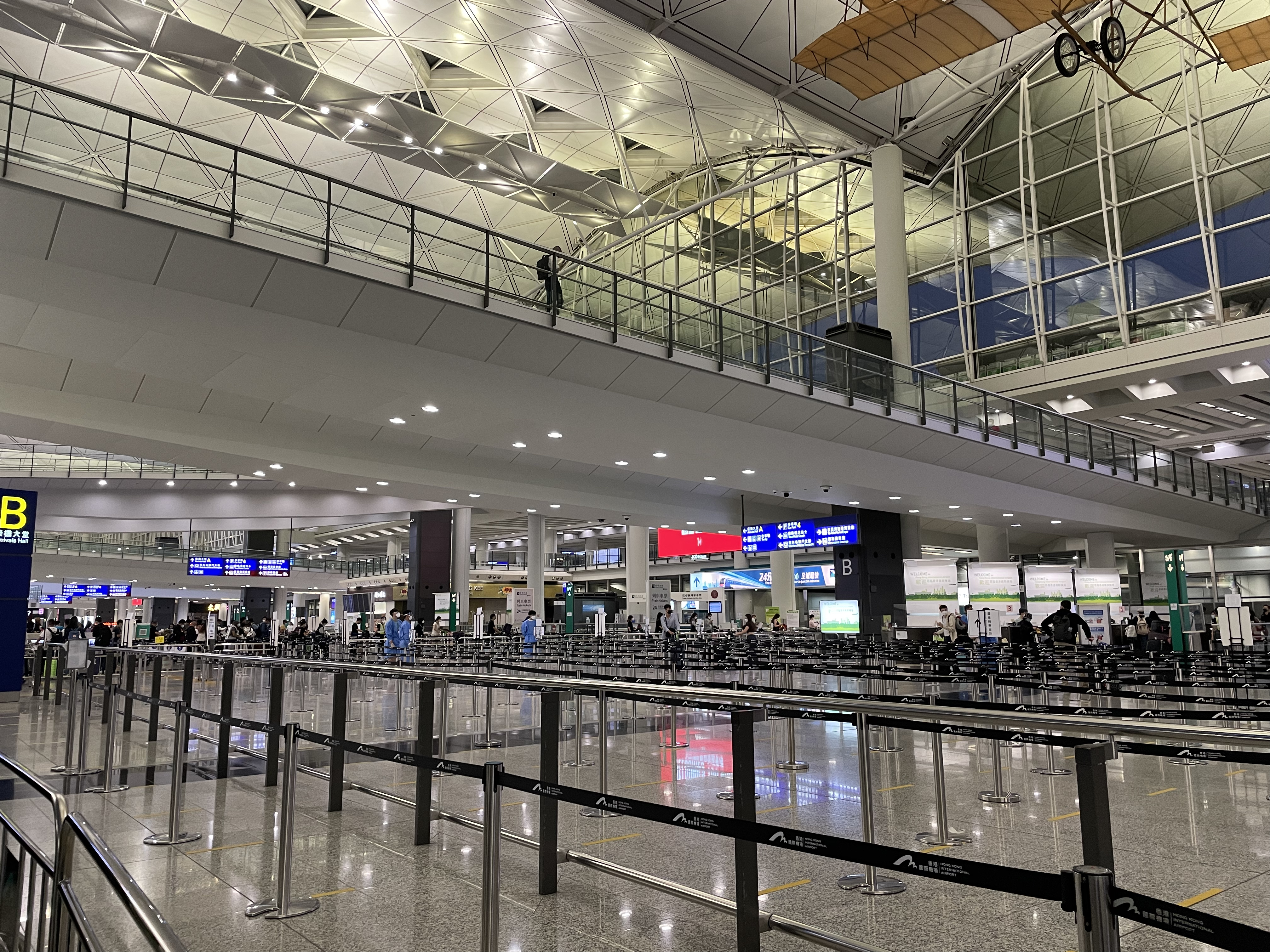
Hong Kong Airport’s repurposed arrivals/shuttle bus waiting hall
This was probably the longest wait I’d had all evening, and all arrivals were funneled into three queues, which were let through at alternating times. I waited in the queue for ~20 minutes, before heading to a counter, where my barcode was once again scanned and I was given a baggage tag with my designated quarantine hotel’s name on it. The airport staff were generally friendly, but were a bit more hurried at this stage of the process – I stopped to put my baggage tag onto my suitcase, and was told to hurry up.
There were twenty separate lanes to wait in, each corresponding to a list of proximate hotels (I think the intent was that a dedicated shuttle bus route would be given to each lane, but because of low passenger numbers, some lanes were grouped together). I was directed to lane 15 (the entrance to the lane had signage with my DQH’s name on it, as well as a few others), and found myself first in line. I figured this meant that I’d just missed a shuttle to my hotel, and had to wait until the queue filled up before I could head to my hotel.
Unlike when I typically board flights, I wasn’t rushing to take unobstructed cabin pictures of the shuttle bus, so wasn’t too happy about the fact that I was first in line (though didn’t mind too much, since I was heading to be quarantined anyway, and wasn’t feeling particularly tired).
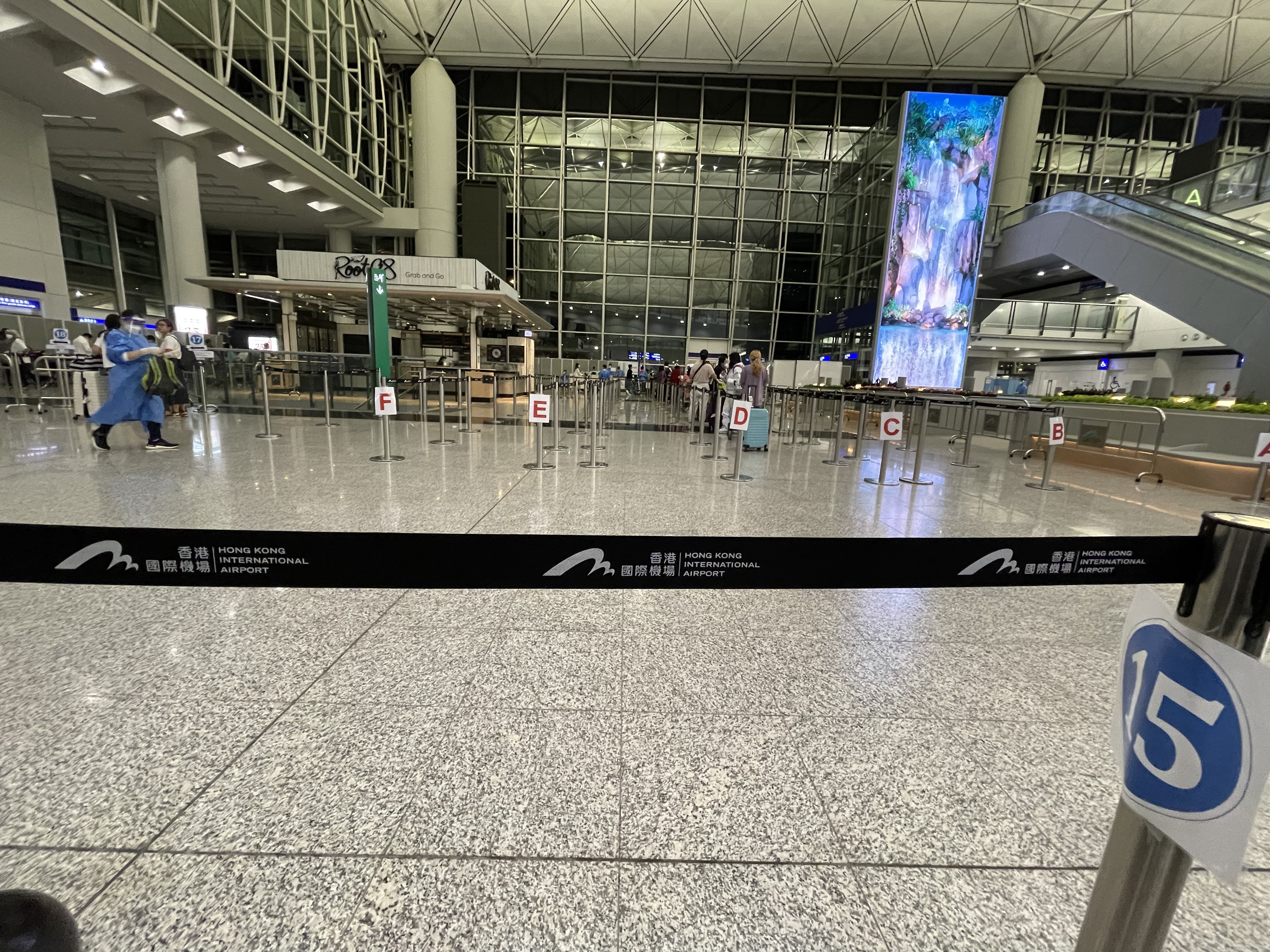
Not enjoying being first in line for my designated quarantine hotel shuttle
It was a further 20-25 minutes before we were called to board together with lane 14, and lined up at yet another queue.
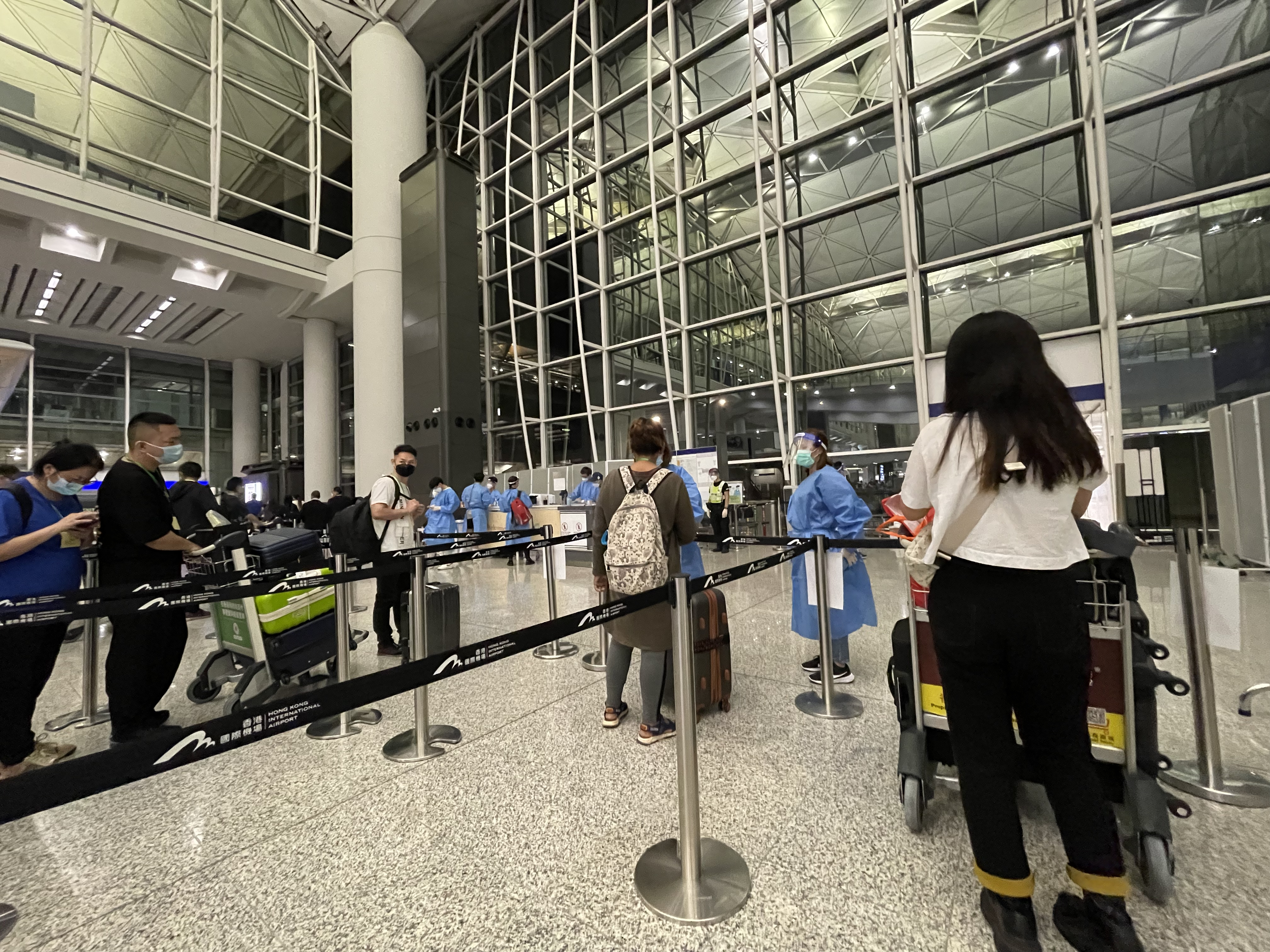
Queue “A” for quarantine hotel shuttle, Hong Kong Airport
After the shuttle bus was prepared for boarding, we were escorted down a lift and onto the shuttle bus (embarrassingly I’d dropped my printed PCR negative test certificate along the way, and a friendly airport staff member handed the certificate to me in PPE, saying that I’d dropped “something very important”). We boarded at 7:25 PM, just over an hour since I’d gotten off the plane, and left the airport at 7:30 PM.
I was fortunate to be put on a 28-seater shuttle bus (some of the shuttle buses were much bigger and had more stops), and the Hotel Indigo Hong Kong was the second stop on the way. I was quite amused when one of the staff onboard asked the driver in Cantonese “what’s our route”, and the driver responded “I don’t know”.
I got to my hotel room at 8:30 PM, a little over two hours since I’d gotten off the plane.
Quarantine and COVID-19 Testing At My Designated Quarantine Hotel
I was instructed to take PCR tests on day 2 (provided at the hotel), 4, 6 and 9 (arrival day counted as day 0), as well as daily rapid antigen testing. Upon checking in at my DQH, I was given a few sheets of paper, including a piece of paper where I had to log my daily rapid antigen tests (I just had to put the date and whether my test was positive or negative, so it wasn’t particularly hard to fill out). I was also instructed by text message to upload all of my test results to eCMSS. I’ll review the Hotel Indigo Hong Kong as a designated quarantine hotel in a separate post (which I think is valuable, since you’re allowed to choose from a wide range of quarantine hotels).
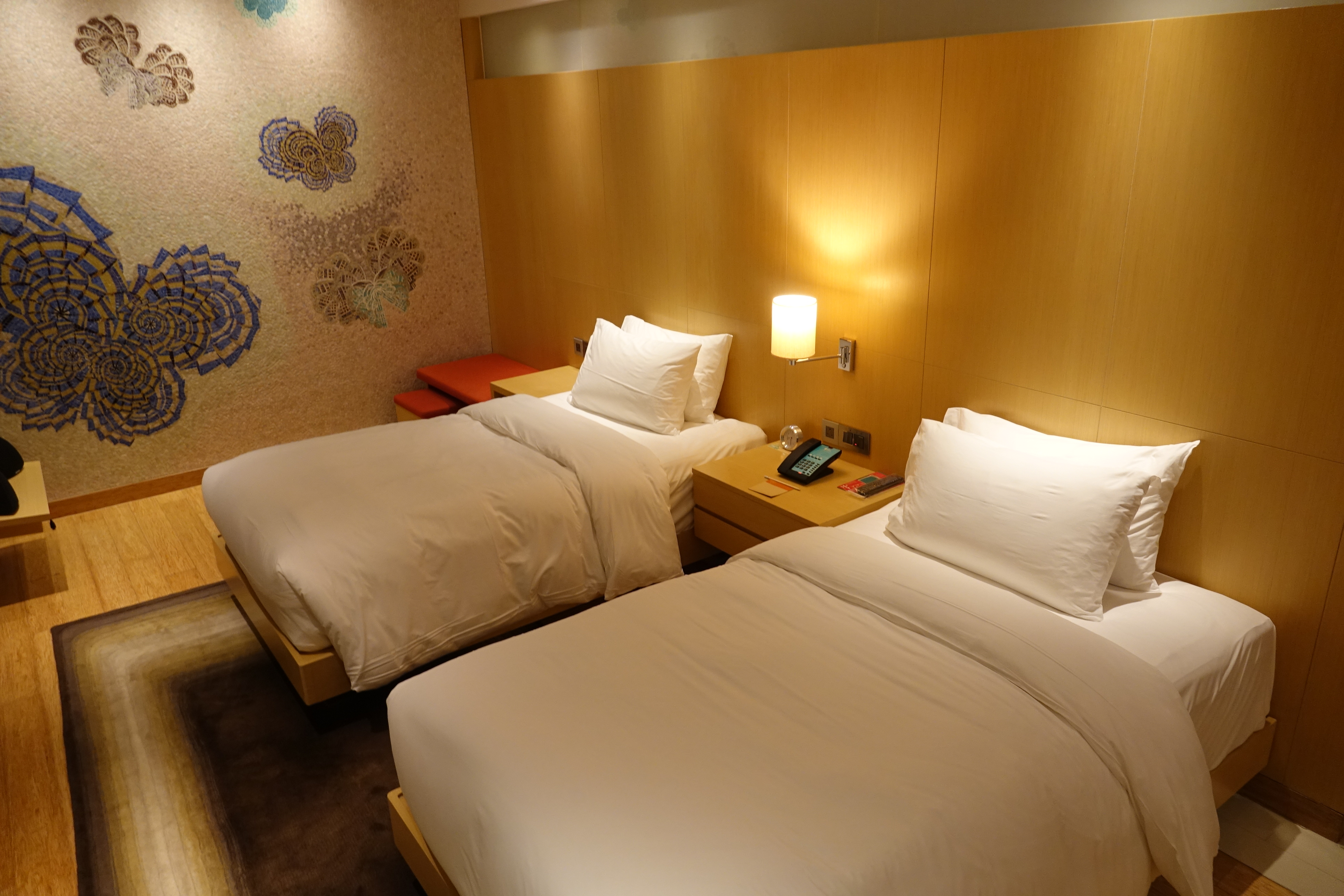
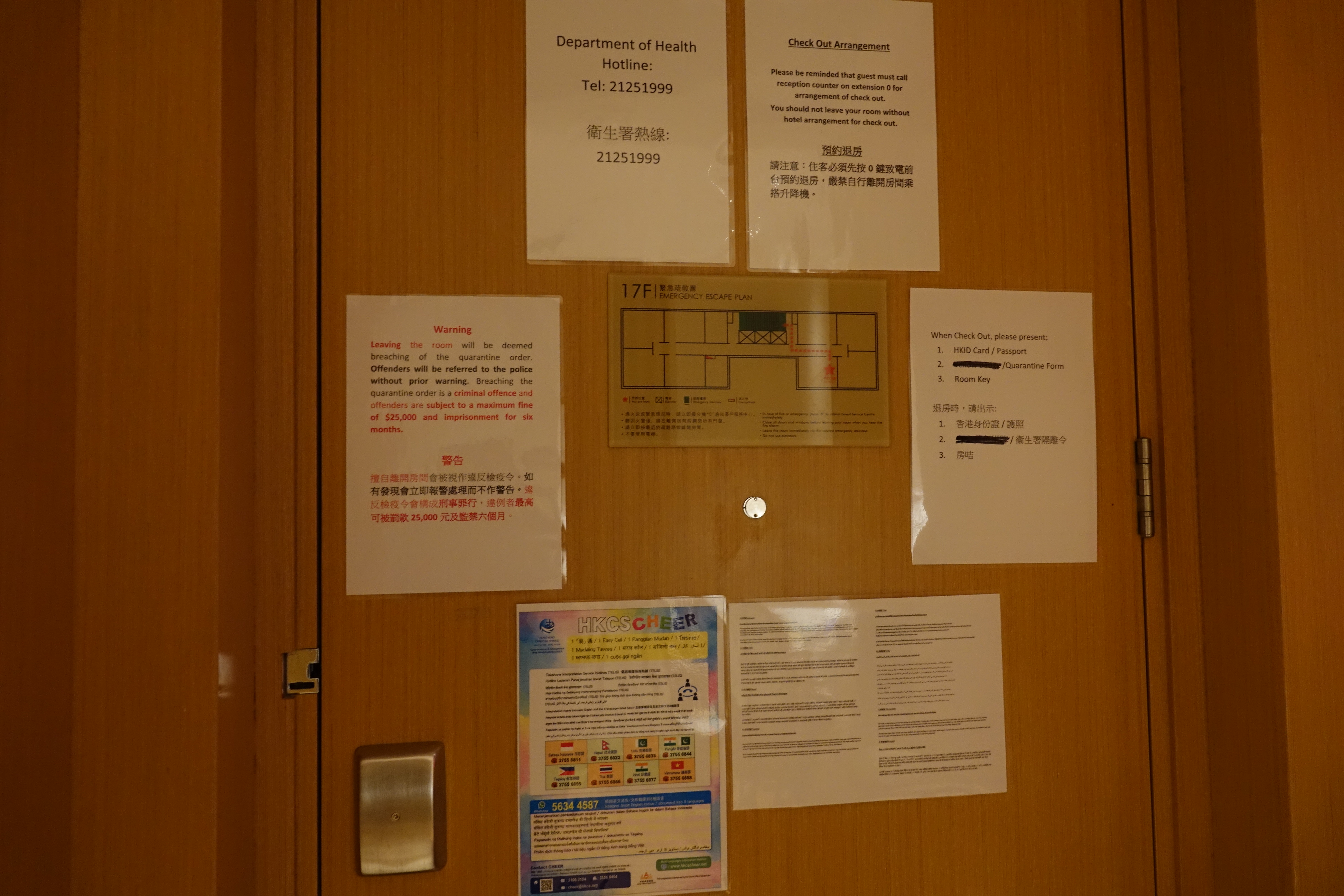
No, Hotel Indigo, I won’t leave the hotel room until I’m instructed to
On the day after I arrived (day 1), I was told that Prenetics would be providing testing services the next day, and to expect them between 10 AM and 5 PM (I was given a number to call if I wanted to have a “special testing arrangement”). That evening the hotel reception called me to expect them at about 11:45 AM.
They arrived at about 11 AM on Day 2, and knocked on my door. Testing was smooth and took less than a minute (though I did find it mildly amusing that I was staring straight at an air purifier as they took my swabs).
Sure enough, I received a negative test result early on Day 3, and the hotel called at 9:30 AM asking when I wanted to check out. My parents were picking me up, so I requested a check-out time of 10:45 AM (ahead of a latest check-out time of 11 AM). I never received a negative PCR result for my arrival test. My LeaveHomeSafe QR (amber) code was checked upon departure, and the hotel took my rapid antigen logging sheet.
It was good to see my parents again, and to spend some time with them at home. I’m still waiting for a “blue code” QR code, which will be given to me on the morning of Day 7 (that’s this coming Tuesday). On that day I’ll be allowed to visit vaccine pass destinations such as restaurants, bars, and church, which I’m not allowed to do at the moment.
Conclusion: Arrivals Experience at Hong Kong Airport
Given the current restrictions and requirements needed to enter Hong Kong Airport, I was impressed by how smooth the process was from start to finish. This isn’t an easy job for airport staff, and they pulled it off well and were in generally friendly (which is very, very hard when you’re working long shifts in full PPE). I felt like checks had gone a long way since my arrival in 2020, which was chaotic, to say the least.
I’m glad to be home, though I’m also awaiting a “0+7” arrangement (which rumour says is imminent), where quarantine hotels will be scrapped entirely. As mentioned earlier, this isn’t an opinion piece of whether I feel like these restrictions are necessary, but rather they’re a rough guideline of what to expect.
How has your experience been arriving at Hong Kong Airport?


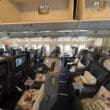
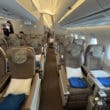
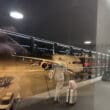
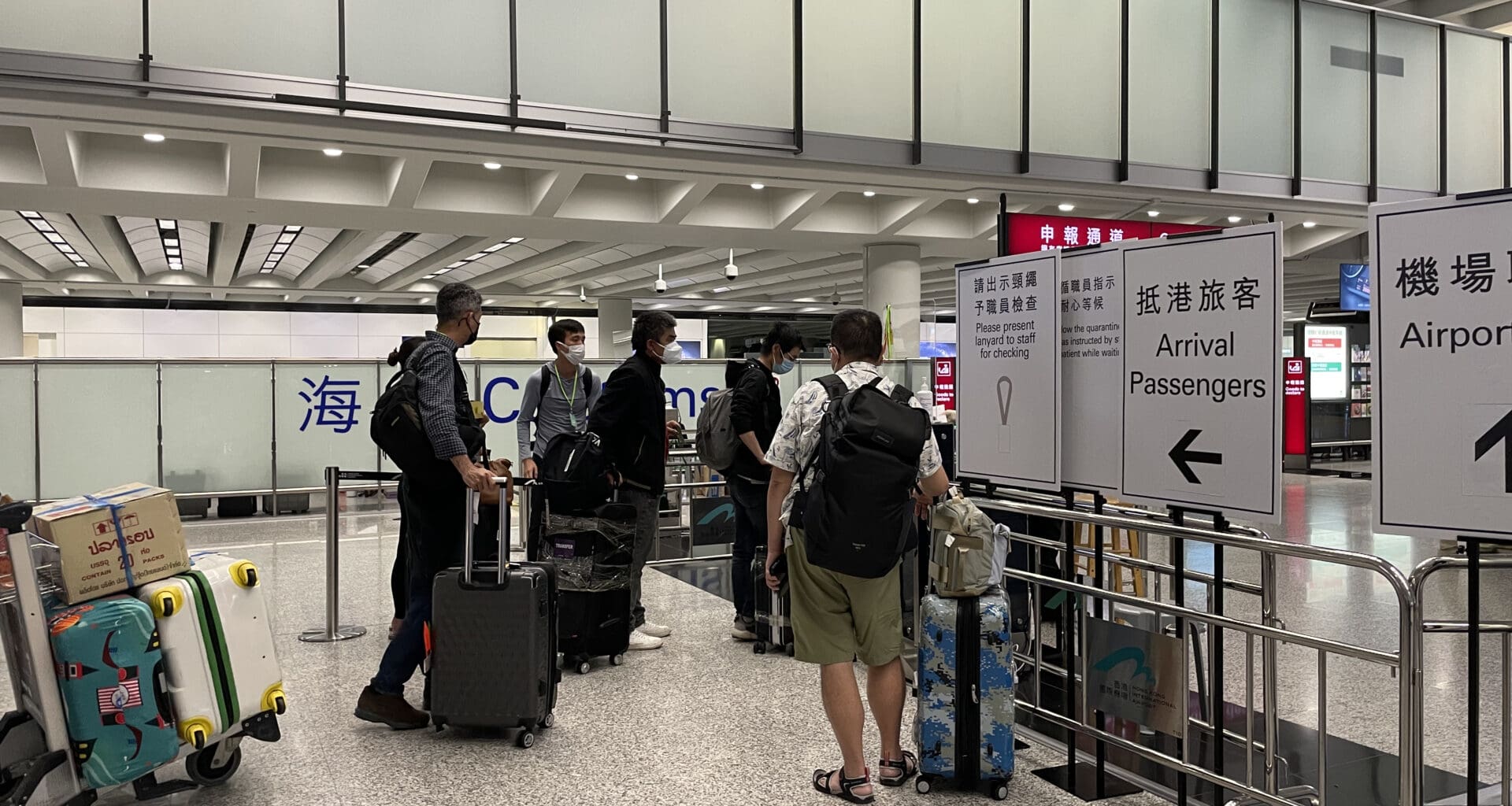
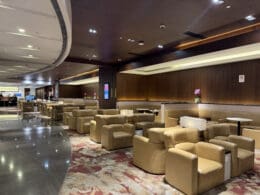
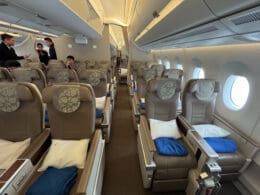
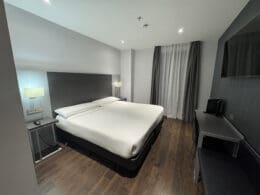
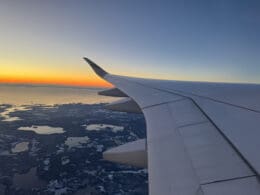
Thanks for the report, very informative. Welcome back.
Thanks for a very detailed and we’ll explained report.